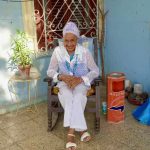Cuba lost one of its legendary voices and artistic figures, the “Lady of Son” Regla Teresa García Catúrla, known as Teté García Catúrla, who passed away in Havana on the afternoon of 4th September 2023 from health complications. Teté was born on the 13th October 1937 in the town of Remedios in the province of Villa Clara. Prior to her death, she was the only surviving child of Alejandro García Catúrla, one of Cuba’s most impactful composers of the 1920s and 1930s who, along with Amadeo Roldán, is considered the pioneer of modern Cuban symphonic music. Educated as a lawyer and musician, he began composing from the age of 15. From his youth, Alejandro García Catúrla was interested in Afro-Cuban rhythms, which marked his compositions as he was the first to fuse Afro-Cuban with symphonic music. Alongside his musical career, he continued his work as a lawyer and later as a judge to support his family. Alejandro was murdered in 1940, at the young age of 34, by a man he was to try in court on that day and he refused to accept a bribe from. As Teté was the youngest of his 11 children and her mother died at birth, she was the only one to take both her father’s surnames.
As a young woman, Teté García Catúrla joined all-female groups “Orquesta Anacaona” and subsequently “Cuarteto d’Aida”. After the death of the founder of the quartet Aida Diestro in 1973, Teté led the group, touring internationally. After her retirement from the quartet, she formed the group “Rumba Teté” for young musicians recently graduated from their schools of music. In the 1980s, Teté was a soloist of EGREM’s group “Estrellas de Areito”. Her work has always been in the traditional popular music of Cuba, performing nationally and internationally from Venezuela to Canada and from the U.K to Japan. In the spring of 1998, she joined the project Afro-Cuban All Stars, travelling to World Music and Jazz Festivals, to halls in Hollywood, Toronto, and London, performing alongside musical legends such as the percussionist Miguel “Angá” Díaz and the trombone player Juan Pablo Torres. Teté participated as a guest soloist in the Buena Vista Social Club Project, specifically performing alongside Omara Portuondo and Ibrahim Ferrer. She released an individual album in 2003 called “Llegó Teté” (Bis Music) and was a contributing singer in the 2015 video “Chan Chan – Song Around the World” by the Playing For Change movement.
Until her death Teté worked at the Guajirito in Old Havana, where she danced and laughed with audiences from all around the world. With her great rhythmic capabilities, unique timbre, dynamic personality, and engaging stage presence, everyone enjoyed her shows. Moving through the tables, swaying her hips while letting her deep voice conquer, Teté got guests to play her shekere and dance with her on stage. Crossing beyond language and national barriers, everyone wanted to join in her vibe and felt the fire of Cuban music in her performance. I would always remember her with a favourite tobacco in her hand, seated in a rocking chair on the patio of her house on Avenida de los Presidentes between 21st and 23rd Street where she lived until her death. The living room was adorned with an old piano, miniature figurines, posters from her performances and those of her father, and photos with her son and family. At dusk, Teté would be always ready early, stylishly dressed and adorned with her religious necklaces, colourful earrings, head turban, makeup done and perfume on. She would be impatiently waiting at the garden gate for her transport to arrive and take her to the next gig. Teté García Catúrla lived for music and the stage until her last breath and part of Cuban traditional popular music and culture dies with her today.



No Comments
There are not comments on this post yet. Be the first one!